Student Spotlights: Class of 2024 Graduates
Before heading off to residency programs, the second class to graduate from the Anne Burnett Marion School of Medicine at Texas Christian University celebrated with fellow horned frogs at TCU’s Commencement at the TCU Ed and Rae Schollmaier Arena on Saturday, May 11.
FORT WORTH – Before heading off to residency programs around the country, the second class to graduate from the Anne Burnett Marion School of Medicine at Texas Christian University celebrated with fellow horned frogs at TCU’s Commencement.
The Class of 2024 matched at prestigious health care systems such as The Mayo Clinic, UCLA Health, Duke University Medical Center, and UT Southwestern Medical Center in March and will continue the next phase of their medical careers as resident physicians.
Class of 2024 Hooding Ceremony
Rebecca Sobolewski, M.D., a graduate of Burnett School of Medicine at TCU, is off to Vanderbilt University Medical Center in Nashville, Tennessee, as an Emergency Medicine resident. She’s learned more than medicine during her time at the medical school.
“I think what TCU has ingrained in me is that it’s not just about your studies. It’s not just about being an adequate physician. It’s also about being an empathetic physician,” Dr. Sobolewski said.
The Burnett School of Medicine opened in July 2019 with its inaugural class of medical students. The medical school’s unique curriculum with a focus on communication and the development of Empathetic Scholars® has uniquely positioned the school to radically transform medical education and improve health care for generations.
STUDENT SPOTLIGHTS
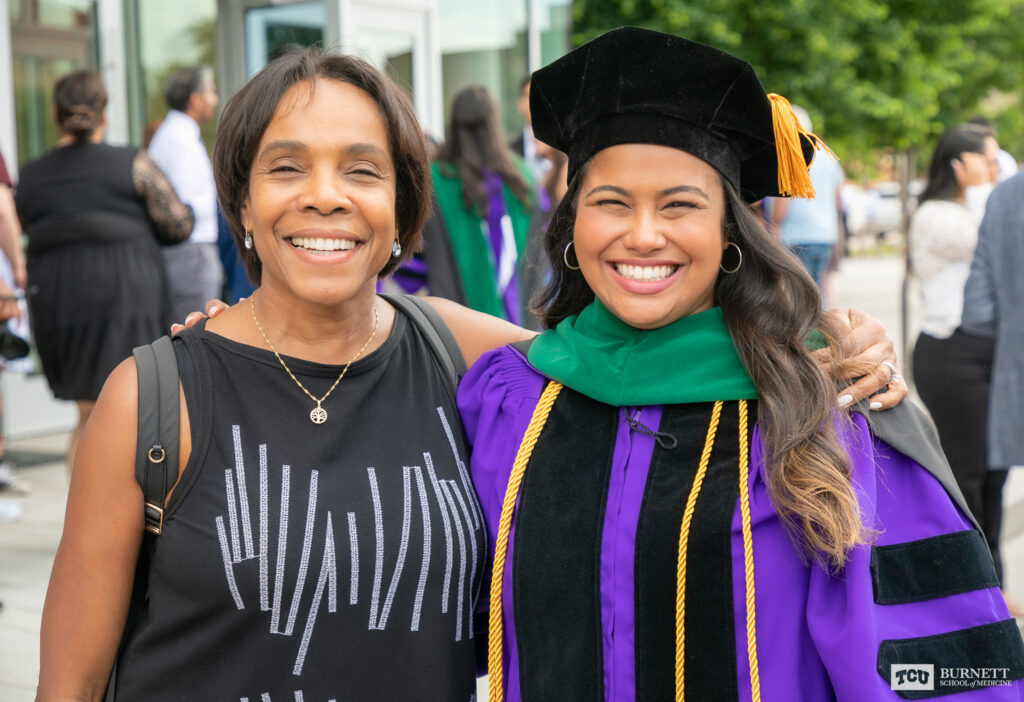
Rebecca Sobolewski, M.D.
Hometown: Chicago, Illinois
Program: Vanderbilt University Medical Center
Specialty: Emergency Medicine
The West Side of Chicago, Illinois, is one of the cities three major sections that include the North Side and South Side. It’s the place that Rebecca Sobolewski, M.D., called home.
“For me, my big thing is community. My community raised me and got me where I am today,” Dr. Sobolewski said.
The West Side is made up of nine diverse neighborhoods, but it is also a place where its more than 480,000 residents experience high rates of chronic diseases such as diabetes, asthma, hypertension, and infant mortality rates far above the national average, according to West Side United a collaborative neighborhood organization.
Dr. Sobolewski’s mother, Ina Braniff, worked multiple jobs to make sure Rebecca and her sister Rachel could attend Chicago’s top primary schools.
“She did lots of random odd jobs to make ends meet,” Dr. Sobolewski said about her mother. “She worked for the airlines and did online interpreting and translating in her off hours.”
When she was around 3 years old, her mom gave her a toy stethoscope and a toddler-size white coat to pretend to be a doctor. Braniff was clear about her daughters’ future professions, Dr. Sobolewski said with a smile.
“She looked at me and my sister and said, ‘one of you is going to be a doctor and one of you is going to be a lawyer,” Dr. Sobolewski said. “My sister was much better at arguing. She took law and I took medicine. She lit that flame and made sure I was able to get the education I needed to get.”
To get there, both women would have to be the first in their family to graduate college, law school, and medical school.
“I wasn’t really surrounded by anybody in my family or anybody else who were physicians,” Dr. Sobolewski said.
It was a long road to get there for Dr. Sobolewski. Her sister would eventually become a lawyer before passing away from complications of epilepsy while Dr. Sobolewski was in medical school.
“It’s really difficult when you’re alone in it and you are kind of figuring everything out for the first time,” she said.
Once she arrived at Baylor University for her undergraduate studies, Dr. Sobolewski began to find support through her pre-medicine program. After graduating, she thought she would leave Texas to attend medical school closer to home, however, her interview at the Burnett School of Medicine changed her heart and mind.
“Every other medical school interview felt like you would be so lucky if we happen to choose you,” Dr. Sobolewski said. “But TCU made me feel like we would be so blessed to have you. That was the big difference for me.”
The Burnett School of Medicine supported her in all of her endeavors in the Fort Worth community and the Student National Medical Association (SNMA) while she studied medicine.
“If I was interested in it, I just had to talk to somebody and that was it. I had support for it,” Dr. Sobolewski said.
It was the extracurricular work she’d done throughout the community that made her stand out during residency interviews.
“The more I talked to people they said, ‘you’re not just a medical student you’ve built so many more identities outside of being a medical student that your application stands out,’” Dr. Sobolewski said.
Now, she wants to spend her career giving back to communities like the West Side of Chicago where she grew up.
As she begins her residency program at Vanderbilt University Medical Center this summer, Dr. Sobolewski views emergency medicine as the front door to health care for many communities.
“Being able to take care of their immediate needs and being the first face that they see is really special and dear to me,” Dr. Sobolewski said.
Sarah Person, M.D.
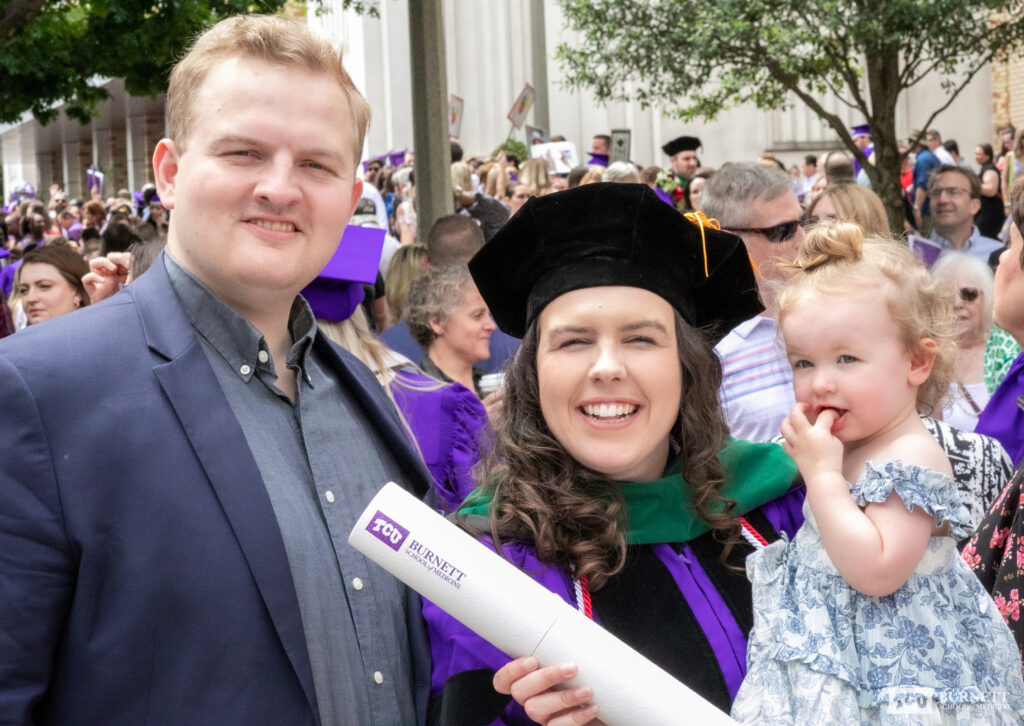
Hometown: Arlington, Texas
Program: Texas Health Resources
Specialty: Internal Medicine
Sarah Person, M.D., was 9 years old when she picked out a white coat and stethoscope for her Halloween costume.
“My grandma got me a white coat and it had Dr. Sarah Powers [her maiden name] on it and I still have that white coat,” Dr. Person said. “I still remember how exciting that felt but I had no idea what that journey entailed.”
While her grandmother might have planted the seed, her desire to pursue medicine took shape in high school while her family lived in Beijing, China. She worked at a special needs orphanage where she met a physician that asked her to assist him checking babies. That enabled her to ask questions about patient care and ultimately solidified her decision to want to go to medical school.
“I just fell in love with understanding the science behind it,” Dr. Person said.
She moved back to the United States and attended Baylor University as an undergraduate before attending the Burnett School of Medicine.
A personal statement letter she wrote as freshman in college about why she would like to go to medical school had some core values that mirrored the core values of the Burnett School of Medicine.
“I remember reading the school’s mission statement and saying, ‘that’s the kind of medical school I want to go to because that’s the physician I want to be,’” Dr. Person said.
Dr. Person matched into the Texas Health Fort Worth Internal Medicine Residency program. The program is a collaboration between the Burnett School of Medicine and the health system to train physicians to practice medicine now and in the future.
The medical school’s Physician Communication curriculum played a key role in her medical training prior to going on away rotations, she added.
“That communication piece set me apart,” Dr. Person said. “I think that is such a missed opportunity in some medical schools and our school spends so much time teaching us how to communicate.”
Christopher Fernandes, M.D.
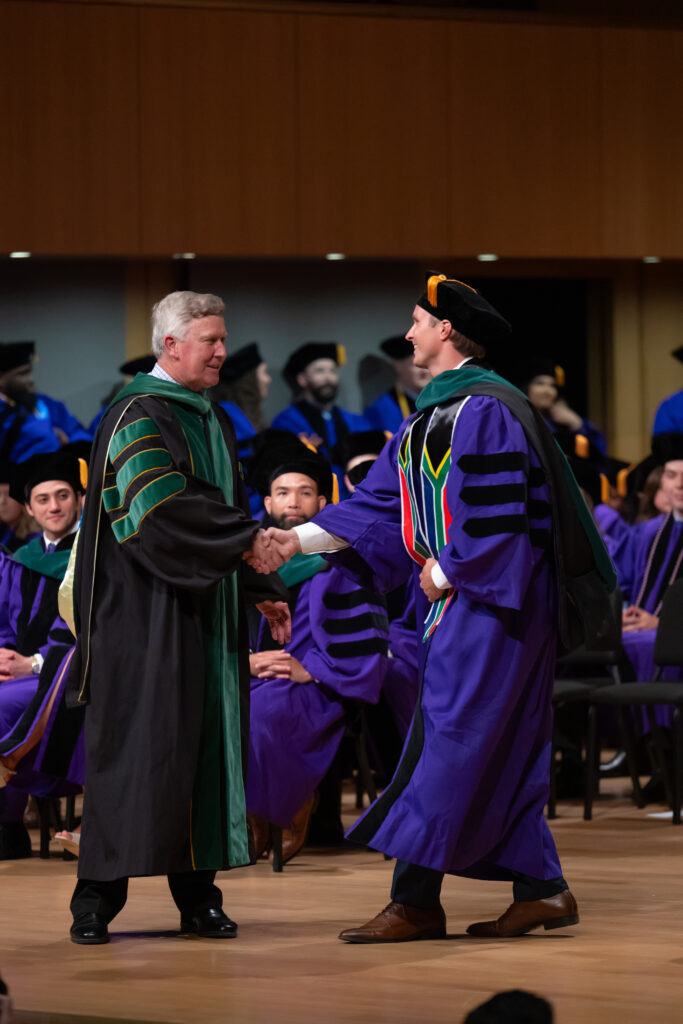
Hometown: Durban, South Africa
Program: Stanford Medicine
Specialty: Emergency Medicine
Surfing and riding waves off the coast of South Africa is where Christopher Fernandes, M.D., fell in love with the ocean. He thought he would be a professional surfer.
He grew up in Durban, a coastal city in eastern South Africa’s KwaZulu-Natal province, which has South Africa’s third largest population behind Johannesburg and Cape Town. He immigrated to the United States alone to pursue his surfing dreams while attending the University of California at San Diego where he competed nationally.
Little did he know that his “side hustle” as an Emergency Medical Technician (EMT) would lead to his future in medicine.
“I worked as an EMT for seven years,” Dr. Fernandes said. “During my EMT work, I really found fulfillment taking care of people and their stories and I wanted to be more involved in their care.”
Interestingly, there were qualities in surfing, such as being adaptive and resilient, that aligned with his newly found passion emergency medicine, Dr. Fernandes added.
“When you surf the ocean is always changing so you have to make decisions with little information,” Dr. Fernandes said. “That’s one of the things I found interesting about working in the emergency room.”
There were specific qualities he wanted in a medical school.
“When I worked with my patients one-on-one in the back of the ambulance or the emergency room, I really wanted that care and getting to know my patients,” Dr. Fernandes said. “My goal was really to make shared decisions with them and really put their health care first.”
The Burnett School of Medicine at TCU’s Empathetic Scholar® curriculum embodied all those qualities. The early and longitudinal clinical exposure in the eight major medical specialties each week gave him a broad scope of health care.
“If Monday was OB, Tuesday was Surgery, Wednesday was Emergency Medicine, so I think practicing all the skills and seeing the large breadth helped to develop the importance of practicing medicine wholly,” Dr. Fernandes said.
This summer, Dr. Fernandes will begin his Emergency Medicine residency at Stanford Medicine.
Nicole Jamieson, M.D.
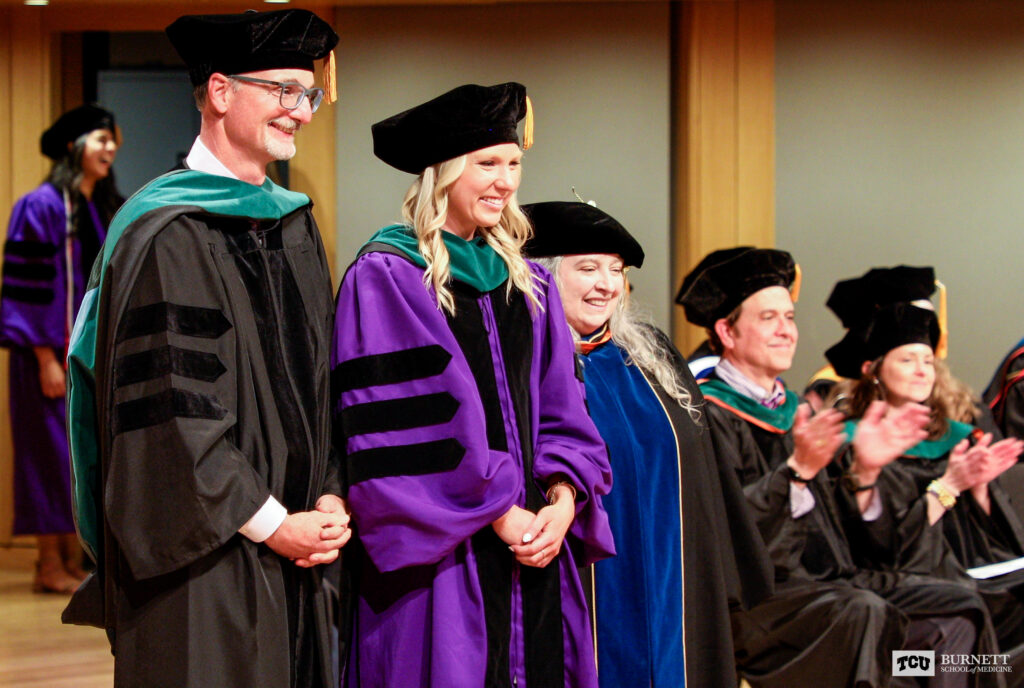
Hometown: Bakersfield, California
Program: Stanford Medicine – Stanford Pediatrics Residency
Specialty: Pediatrics
What do you want to be when you grow up? It’s the age-old question children hear from adults.
When Nicole Jamieson, M.D., was in sixth grade on the ride home from school, her mother asked that question.
“I said, ‘I don’t know. I think I want to be a doctor,” Dr. Jamieson said. “But it kind of seems like a lot of work and daunting.”
Her mom reassured her that she’d be a great doctor if she put her mind to it, Dr. Jamieson added.
“Ever since that moment that’s all I wanted to be,” Dr. Jamieson said.
She completed her undergraduate studies in psychology and children’s research at University of Texas at Austin before coming to the Burnett School of Medicine. She knew that working with children and understanding psychology was her passion before medical school, but she needed to find a focus.
What she wanted from her medical school experience was a chance to connect with patients. From the moment she interviewed at the Burnett School of Medicine, she knew it was a place that could mold her into the type of physician she wanted to be.
“Their mission of the Empathetic Scholar® was just so pronounced and everyone was seeming to walk the walk,” Dr. Jamieson said. “That was something I never wanted to lose sight of as a physician. You’re not just treating patients; you’re treating people with a whole life outside the moment that you’re seeing them in.”
Through the Longitudinal Integrated Clerkship (LIC) curriculum, Dr. Jamieson found her focus in pediatrics. The early clinical exposure set her up for success during her away rotations, which led to her match at Stanford Medicine, she said.
“By the time we got to the end of our third year and our fourth year, all of us were comfortable in the clinical environment,” Dr. Jamieson said. “The longitudinal relationship that I had with patients and my mentors really helped develop my skills overall.”
Caden Duffy, M.D.
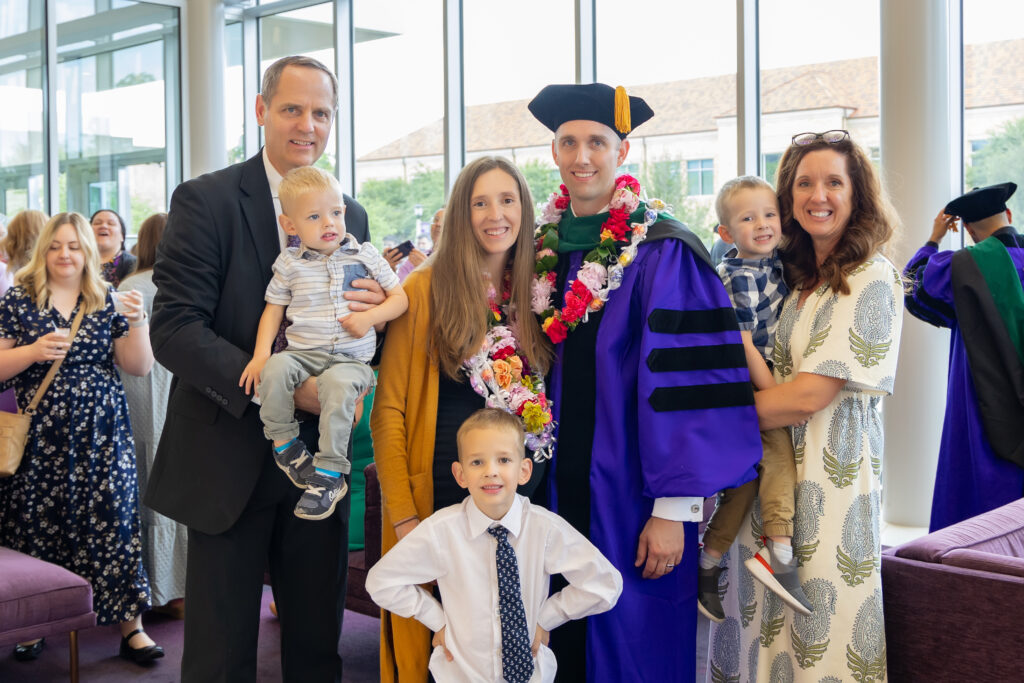
Hometown: Salt Lake City, Utah
Program: University of Iowa Health Care
Specialty: Otolaryngology
The road to becoming a physician can take many forms and for some making a pivot during their undergraduate education can happen.
“I actually always wanted to be an engineer growing up,” Caden Duffy, M.D., said. “I was thinking mechanical engineer or chemical engineer for a while.”
His love for science didn’t blossom until his sophomore year at Brigham Young University. He participated at a free clinic in Provo, Utah, which has a large Spanish-speaking population. He was fluent in Spanish, so he was able to help translate for patients. Those interactions are what led to his medical journey as a physician.
“That’s when I felt like I really had a connection with the patients I felt like that was something I wanted to do with the rest of my life,” Duffy said.
Following that experience, he went back to that clinic for about four hours every Thursday night until graduation. After taking two gap years doing medical research, he made the choice to attend the Burnett School of Medicine at TCU. His decision to attend had a lot to with his previous experience working with Spanish speaking populations.
“That’s one of the things I was excited about moving down here to Texas and there’s an even higher percentage of Spanish speaking populations,” Dr. Duffy said.
He credits the Burnett School of Medicine’s LIC curriculum and extended clinical exposure with giving him the tools to connect with patients and attending physicians during away rotations.
“I felt like I was able to make great relationships with those attendings during the LIC and they were my biggest cheerleaders in helping me get to where I wanted to be,” Dr. Duffy said.
He matched into Otolaryngology (Head and Neck Surgery) residency at University of Iowa Health Care. Otolaryngologists treat any condition medically or surgically from the chest clavicle up to the head around the brain.
There were 123 participating Otolaryngology programs in the U.S. during the 2023-2024 Electronic Residency Application Service (ERAS) cycle, according to the American Association of Medical Colleges (AAMC). Residency spots differ per program. Some otolaryngology programs have 5-6 residents per year, while others may have 1-2 residents per year. The University of Iowa was his top ranked program for Match Day.
“That week for me was pins and needles because I had only applied to otolaryngology programs,” Dr. Duffy said. “I was so excited to have matched at my top ranked program.”